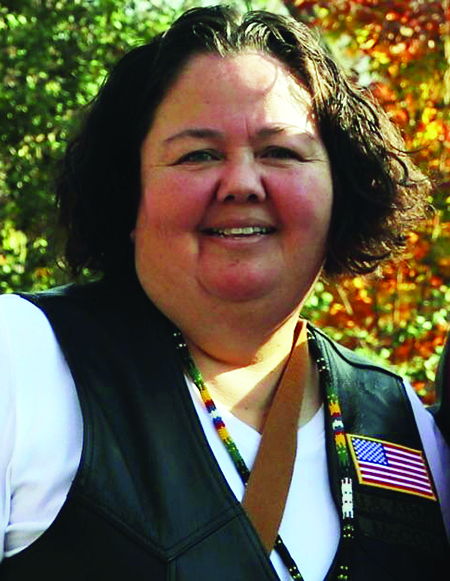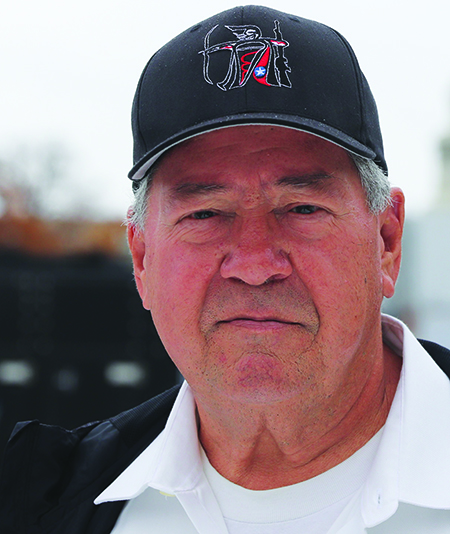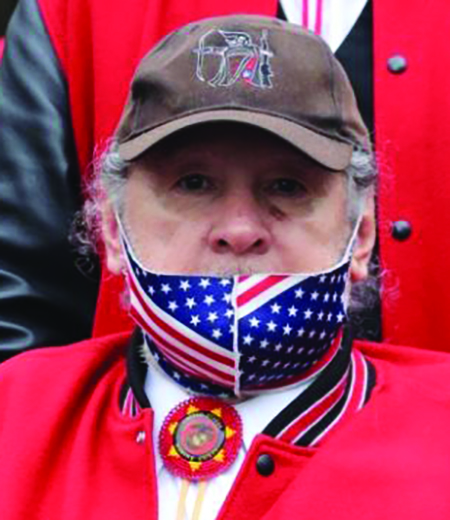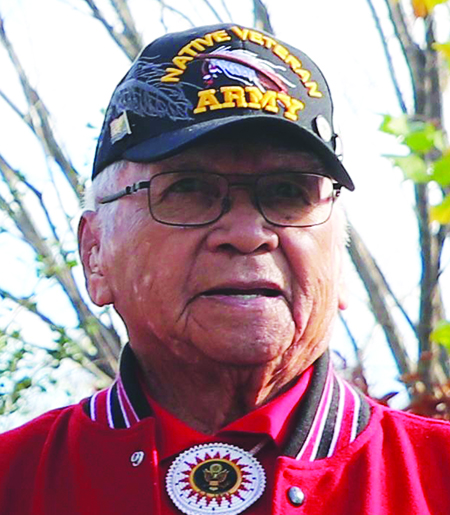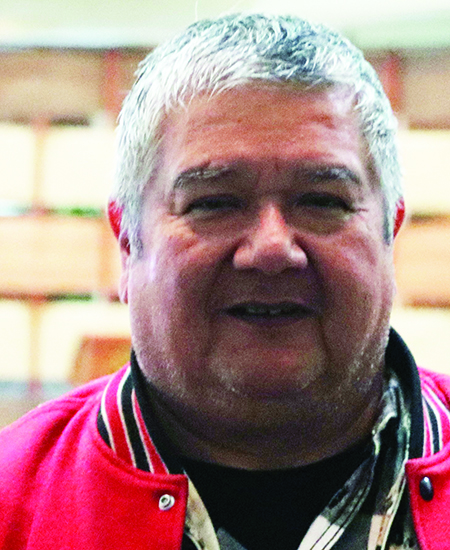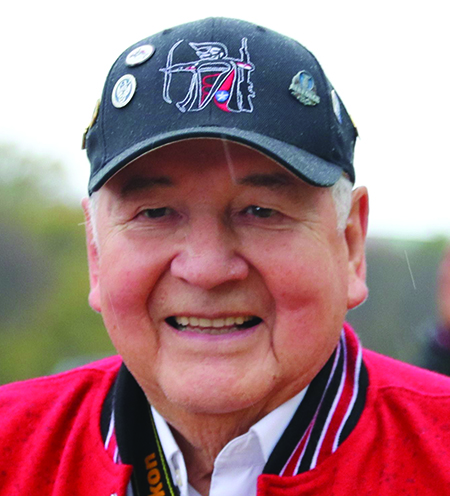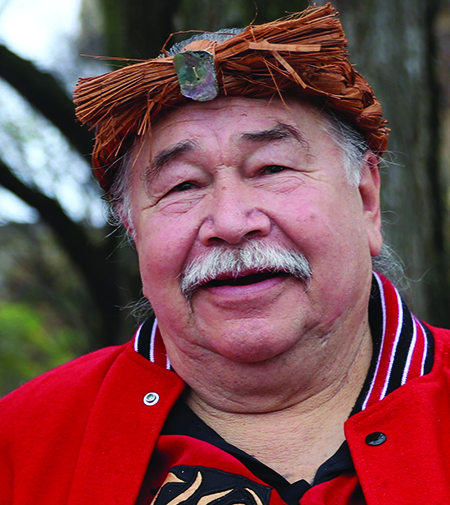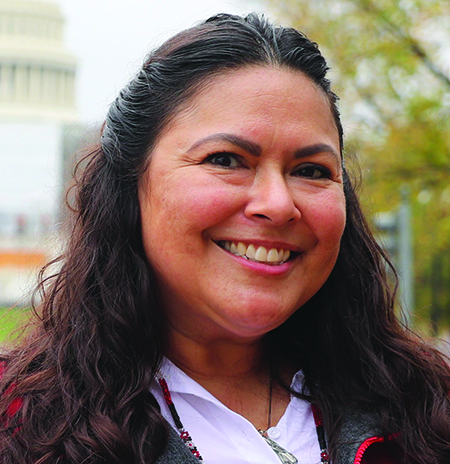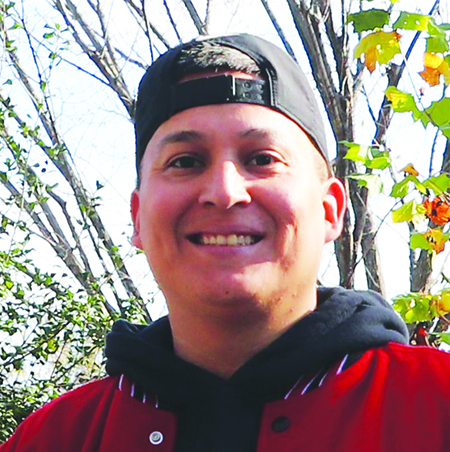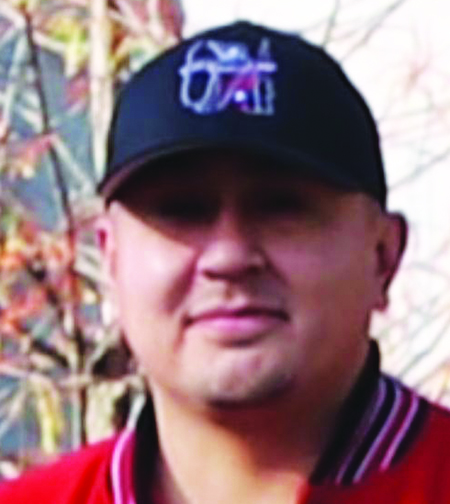Please use the following link to download the December 3, 2022 issue of the syəcəb
Author: Kim Kalliber
A conversation with Faith Iukes and Chef Pyet
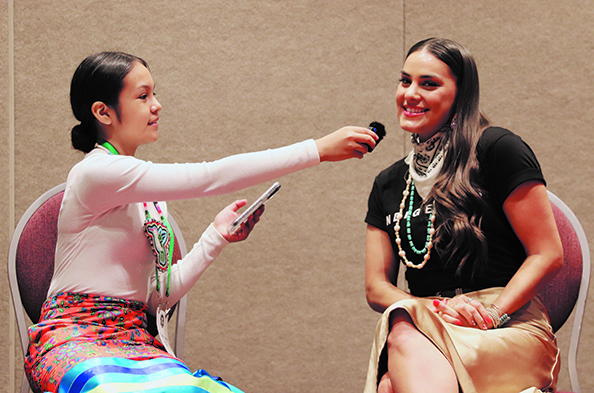
By Kalvin Valdillez; photos courtesy of Kalvin Valdillez, Chef Pyet and Faith Iukes
Meet Chef Pyet
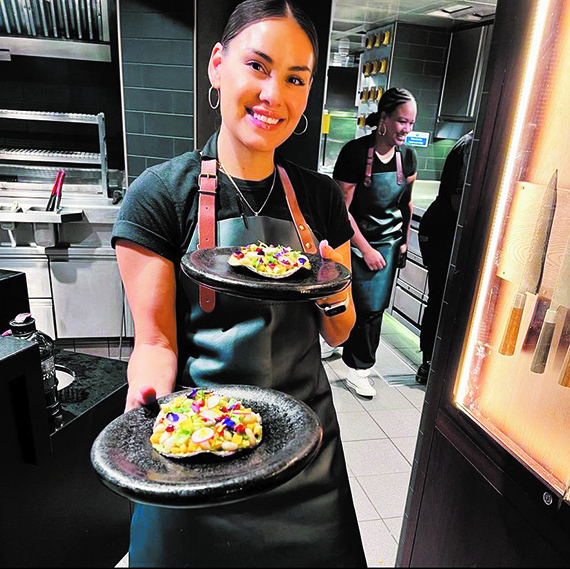
At the beginning of 2022, a new cooking show by Gordon Ramsay debuted on the Fox network called Next Level Chef. In this primetime show, fifteen chefs compete against each other and are placed on one of three tiers; the top kitchen is equipped with all the latest cooking gadgets, the second kitchen features standard equipment used in kitchens nationwide, and the bottom kitchen has limited and outdated equipment making the challenges all the more difficult.
At the end of the eleven-episode season, Chef Stephanie ‘Pyet’ DeSpain of the Prairie Band Potawatomi Nation Tribe was crowned the very first winner of Next Level Chef. Throughout the show she incorporated her Native American and Mexican heritage into each plate and simultaneously brought Indigenous teachings, knowledge, and history to homes all across America. In addition to a 250,000-dollar cash prize, Chef Pyet also won a one-year mentorship from each of the esteemed Next Level Chef judges – Nyesha Arrington, Richard Blais, and Gordon Ramsay himself.
Chef Pyet was also listed as one of the top ten best private chefs in Los Angeles in 2021. And from the exposure of Next Level Chef, she has elevated her brand. During the first week of October, she was the guest chef at Ramsay’s very first restaurant in Chelsea, London, the Lucky Cat. Recently, she utilized her platform to help raise funds for the UNITY scholarship for Native Youth, and just this week she announced her first cookbook deal with HarperCollins Publishers.
On an Instagram post she stated, “I can’t wait to share this book with you all. I am setting intentions to celebrate Native American culture with curated recipes that tell my story of how I’ve found healing and comfort returning to my ancestral food ways.”
As mentioned earlier, Chef Pyet collaborated with UNITY and is a strong advocate and supporter for Native youth. In fact, this was not her first time working alongside UNITY. Back in July, she served as the keynote speaker at the UNITY Conference in Minneapolis, where she shared her story with the youth and encouraged them to always be their true selves on their personal journey throughout life. No doubt, her words made a huge impact on the kids who flocked to her for selfies after her speech and were starstruck to see a young Native woman making huge waves in her desired career path.
Meet Faith
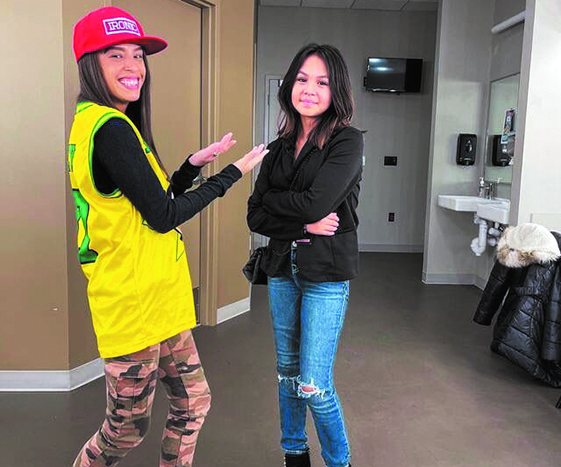
In attendance of the 2022 UNITY Conference was none other than Tulalip’s own social media influencer Faith Iukes, who was invited to the conference for media coverage. Faith had the pleasure of meeting and interviewing several of the keynote speakers and panelist at the conference.
At the young age of 13, Faith has been making big moves on the social media circuit over recent years. Currently she boasts 12.2k followers on Instagram, 11.3k followers on TikTok, and 1k followers on her Twitter and YouTube pages respectfully. And with a strong team of supporters backing her as she follows her dream, Faith is just getting started.
Faith also hosts her own online radio station on Soundcloud and www.FaithIukes.com, which features music and conversations from Native artists throughout the nation. She is always hard at work, creating content on a daily basis and has numerous endorsements and partnerships with Indigenous brands such as Rise Above and Generational Trauma. And she also steadily promotes other Natives, whether it be music, fashion, comedy, film/tv, culture, or art, Faith is quick to share and support the work of her fellow Indigenous creators in the entertainment industry.
At the latest Mariners Native American Heritage Night, Faith was asked to be the special guest announcer for the game and was seen calling the ballgame on the jumbotron. She has also done some great work with the Seattle Kraken, a partnership that was developed before the newly established NHL hockey team even hit the ice. Most recently, she helped bring an Indigenous Fashion Show to the Pacific Northwest along with her mom Alexis and NSO Entertainment and was featured as one of the show’s models. And although she is a big supporter of Native athletes, she wants to serve as inspiration to other Indigenous youth and show that you can follow a successful journey and make a name for yourself outside of the sports realm.
As her viewership and followers continue to grow, Faith is taking in as much as she can and learning from other Natives in the entertainment game. In just two years, she has cultivated a following and has done all the camera work, interviewing, DJ’ing and editing on her own.
About her time spent at the UNITY Conference, Faith shared, “I’m working with the organization and bringing light on the social media scene and doing work with the keynote speakers and doing interviews. My experience has been great. It’s very exciting. I love the people and the chaperones. I made a lot of new friends. I’m gaining a lot of inspiration from them. I look up to everybody who I interview because they all have good energy and a great mindset. UNITY invited me and that’s pretty cool because I really want to inspire our youth, and I am the youngest person to be invited. This is my first time traveling on an airplane too and it’s without my family, so they are all kind of nervous. And I was pretty nervous myself but it’s really exciting.”
A conversation with Faith Iukes and Chef Pyet:
Faith got an exclusive interview with Chef Pyet following her keynote speech at the UNITY Conference. A special moment took place in a conference room of the Minneapolis Convention Center as two young up and coming Native women met for the first time and shared a quick conversation after complimenting each other on their Indigenous jewelry, ribbon skirts, and fly kicks.
Faith: Can you give me a brief history of who you are?
Hello, my name is Chef Pyet. I’m a member of the Prairie Band Potawatomi Nation Tribe and I’m also Mexican American. I grew up in Kansas City and now I live in Los Angeles as a private chef. I just recently won a Gordon Ramsay cooking show and I specialize in Indigenous fusion food where I highlight Indigenous foods of the Americas.
That’s great! What’s the first app you open on your phone in the morning?
The first app I open is my calendar. I have a Google calendar and it really allows me to know my timeframe in the morning to get settled in and get my meditations or my prayer in.
Cool. What are some words of encouragement you can leave for the youth and our future generations?
I think for me, it’s really important for our youth to focus on being their true authentic selves. The reason why I say that is because a lot of Indigenous people in this country have felt kind of ignored or maybe looked passed, as if their lives don’t matter, and it’s hard to show up and be your true authentic self when people are saying your life doesn’t matter. I think it’s important there’s representation in the world for people like them. You never know who’s watching you, you never know who’s going to be inspired by what you’re doing or what you’re saying. So, I think it’s important for people to show up as themselves and give people who are watching permission to also be themselves because authenticity is something that we’re missing.
That is amazing! If I pray for you, what should I pray for?
Well first of all, thank you for asking that question. I also wanted to say before I answer this question that I think it’s incredible that this is one of your questions. I never had someone ask me that question in an interview. When I saw that, I thought wow, this girl is going places. Thank you so much for asking that. If you were to pray for me, I would definitely say please pray for strength because the line of work I am in requires a lot, and a lot of work. It requires a lot of emotion, whether that be internally for myself or for other people. The work that I am doing requires me to go inward and be really intentional with what I’m doing, so strength is something that I could utilize.
Be sure to follow these two amazing ladies on all your social medias!
Chef Pyet
- Instagram/TikTok/Twitter: @ChefPyet
- YouTube: @ChefPyet5754
- Facebook: Pyet’s Plate
- Official Website: www.PyetsPlate.com
Faith Iukes
- Instagram/TikTok: @Faith.Iukes11
- Twitter: @IukesFaith
- YouTube/SoundCloud/Facebook: Faith Iukes
- Official Website: www.FaithIukes.com
Indigenous café opens in Seattle
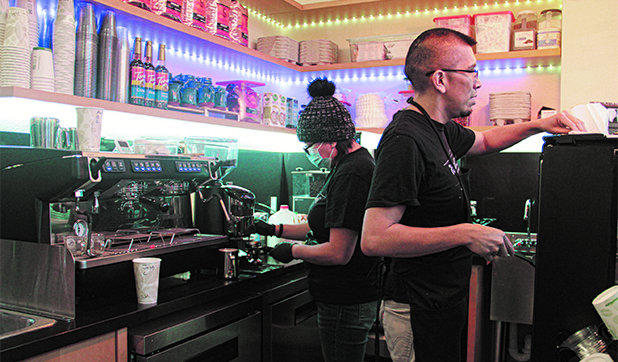
By Shaelyn Smead, Tulalip News
On November 29, the ?ál?al Café by Chief Seattle Club (CSC) opened in the heart of Seattle’s Pioneer Square neighborhood. Unlike the other 300+ cafes in Seattle, ?ál?al Café disrupts this metropolitan lifestyle by reclaiming and reintroducing traditional Indigenous foods in a modern café setting. CSC’s ideologies and the basis of their work are to uplift our culture across North America and support unhoused Natives in Seattle.
In addition to the Café’s full espresso bar, ?ál?al offers quick-serve cuisine highlighting Indigenous ingredients from all over North America. The café strives to use elements that predate colonial descent, including Great Plains’ bison, the Southwest’s Three Sisters, the Northwest’s salmon, etc. These Indigenous foods have been carefully procured by selected indigenous-owned companies and suppliers across the continent. Some ingredients and food products were displayed and available for purchase, along with Indigenous-made cookbooks for customers to take home and try for themselves.
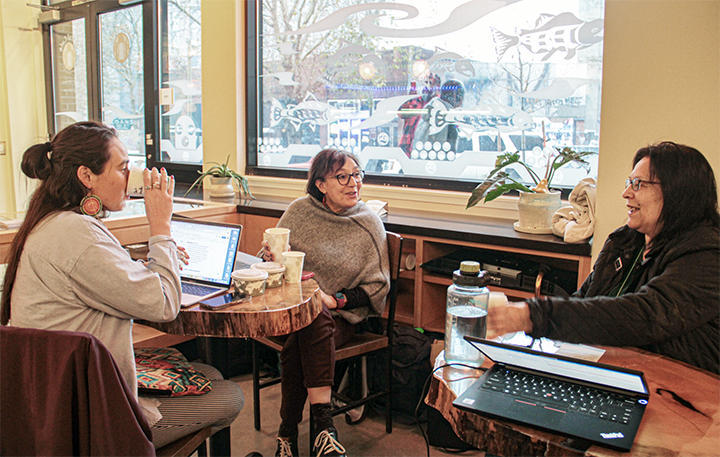
So often in the modern world, we see restaurants, cafés, grocery stores, and markets covering various cultures, yet Indigenous culture is still often overlooked and ignored. But as many cultures across the US proclaim, representation matters.
The café manager Anthony Johnson agreed, saying, “We want to decolonize the food industry. You look at areas like Chinatown and see a massive district full of vibrant culture and community. We believe that as this land’s first peoples, we should be no different. It is important to have representation and for our people to be seen. We want Native folks to come in, feel like they control themselves, and can call this place a home.”
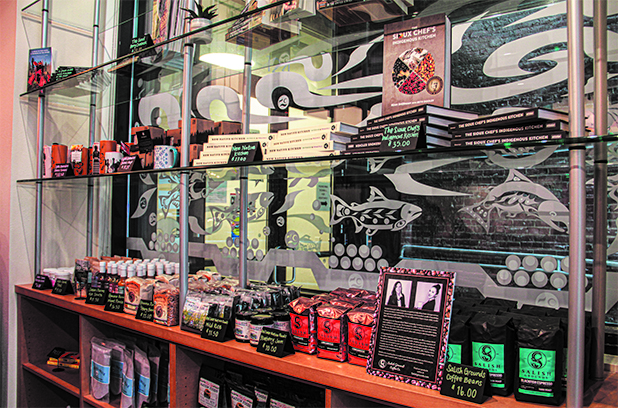
Along with consuming delicious foods and drinks at their live edge spruce-made tables, patrons also enjoyed the handcrafted and curated Indigenous artworks displayed all over the café. The art is also set to change seasonally throughout the year and feature different artists. Shown on the center wall of the café is a 3-D mural collage of Chief Seattle, an eagle, Mt. Rainier, a canoe, basketry, salmon, etc. Additionally, on the street-facing windows, a display of translucent salmon artwork is visible for bypassers to see.
In the background, customers will hear singing, drums, and various Indigenous music. With this idyllic atmosphere, decolonization expands from food and drink to Indigenous conversations, artwork, and spaces. Their website says, “Connection to traditional dishes goes beyond taste and conversations around the dinner table. Food connects us to our culture; to our Indigenous roots and identity.”
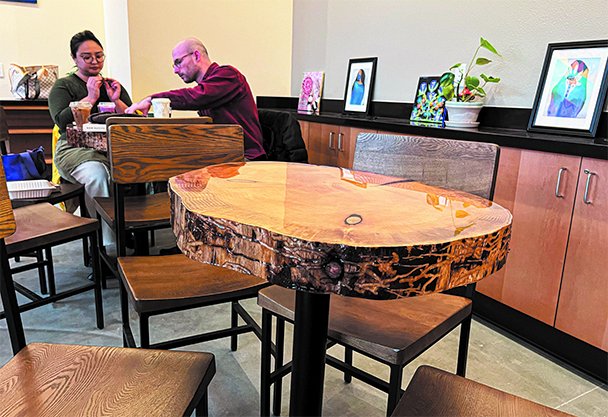
Anthony also spoke about how the storefront acts as a bridge from Native communities to the public, “It opens up a broader conversation for people. If they see some characters, glottal stops, or linguistics marks from our language that they don’t understand or don’t know how to pronounce, it opens up new discussions. People will become more curious about the language of the Puget Sound, how we speak it, and what it means.”
The name ‘?ál?al’ derives from the Lushootseed language that is Native to this land, and the definition of it means ‘home.’ Currently, the café employs an entire Indigenous staff with a few job openings still available. ?ál?al Café is located on the ground floor of their landmark Native urban permanent housing complex that CSC constructed with 80 units in January earlier this year. The residence provides housing for struggling Native Americans to find connections and stability. According to CSC, in 2022, Native Americans face the highest poverty rate than any racial group in King County, with over 15% of the homeless community being American Indian or Alaskan Native.
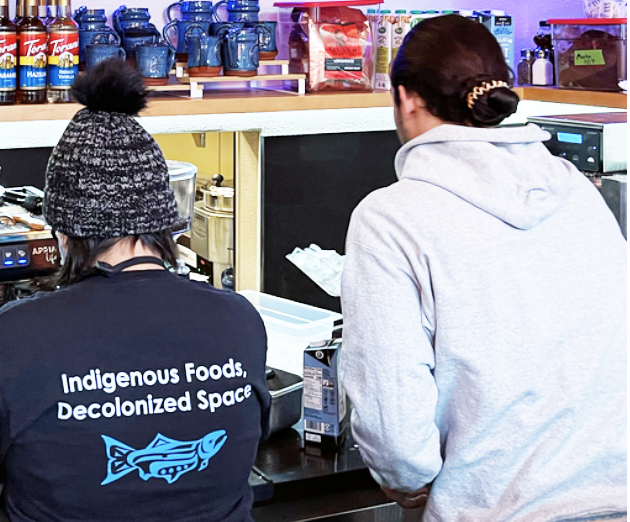
Being involved with CSC for over 12 years, Anthony said, “A vast majority of Seattleites ignore or turn a blind eye to the housing security crisis. But we want our communities to take action. This is just one of the ways to help. Come in, have a cup of coffee, and think deeply about the issues that the city and our people are facing.”
100% of the Café’s net profit will go back into the 501(c)(3) organization and support the work for unhoused Native people. Private donations are a significant source for the non-profit; they always look for donors and people to get involved. You can visit ?ál?al Café at 122 2nd Ave S. Seattle, WA 98104, Tuesday-Friday from 6:30 AM – 2:30 PM. For more information, please visit their website at: www.alalcafe.org.
Quil Ceda Village presents ‘Lights & Ice’
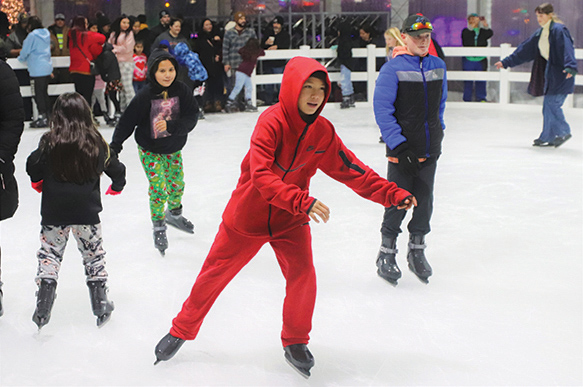
By Micheal Rios, Tulalip News
Millions of dazzling Christmas lights make Quil Ceda Village (QCV) impossible to miss for an endless number of passers-by driving along I-5 this holiday season. The beautiful illuminations, which span the entire color spectrum, provide a timely electric décor wrapping towering trees and ground level shrubbery at the Tulalip Resort Casino, Tulalip Bingo and Tulalip Amphitheatre properties.
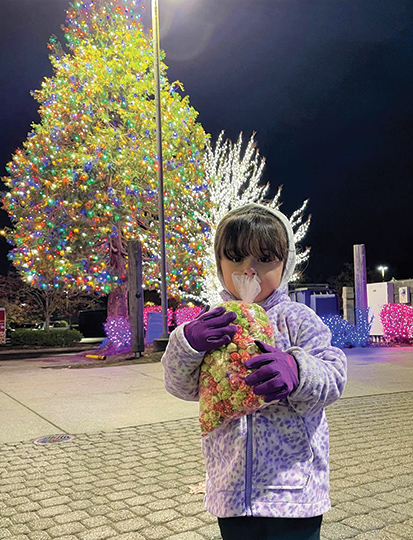
“This is years is in the making,” explained QCV general manager Martin Napeahi. “We’ve been thinking of different events we could have at our Tulalip Amphitheatre for families. Last year, we partnered with Blue Line Entertainment to sponsor a skating rink at the Everett waterfront. After seeing the success of that rink, we decided to bring it here to Quil Ceda Village.
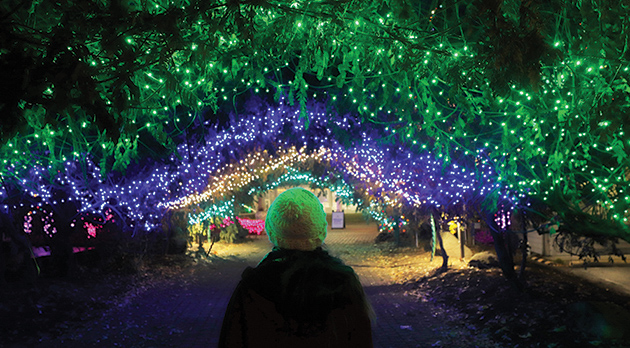
“The atmosphere is electric. It brings added excitement for our customers at the outlet mall and guests at the casino to have another way to experience the holiday season,” continued Martin. “This Ice & Lights event is really geared towards our families and is a fun, festive experience for all to enjoy. Between the food vendors and craft vendors, this is an opportunity for our tribal entrepreneurs to make some extra cash. It’s a really great feeling to be able to bring this to our community and help boost the local economy.”
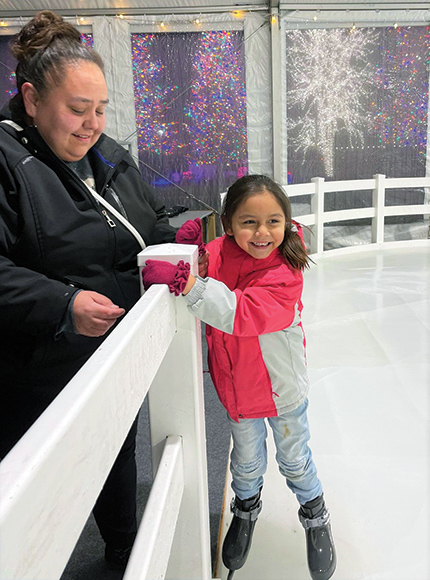
An additional boost of excitement invigorated the local community during the debut of an ice-skating rink at the amphitheater, located between the Resort Casino and Seattle Premium Outlets. Tulalip families and friends were afforded the privilege of first skate on the evening of November 21st after a proper opening ceremony held by Tulalip and QCV leadership.
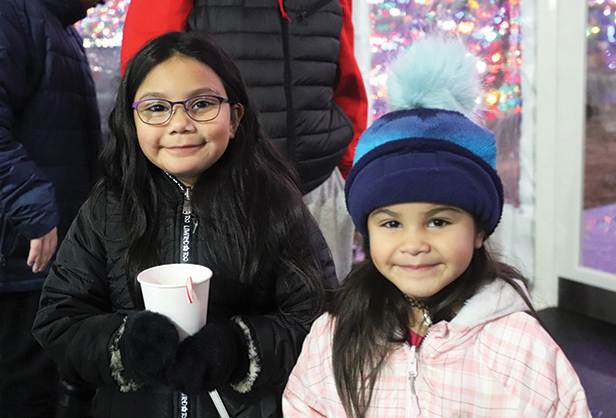
While some ventured around outside in search of the perfect family Christmas photo, others sought their first ever experience at ice skating. The enthusiastic naivety of Elementary-aged children rushing to put their skates on and hit the man-made glacier provided smiles, candid photo moments, and a laugh or two by elders seeing the kids quickly plunk to their butts on the ice.
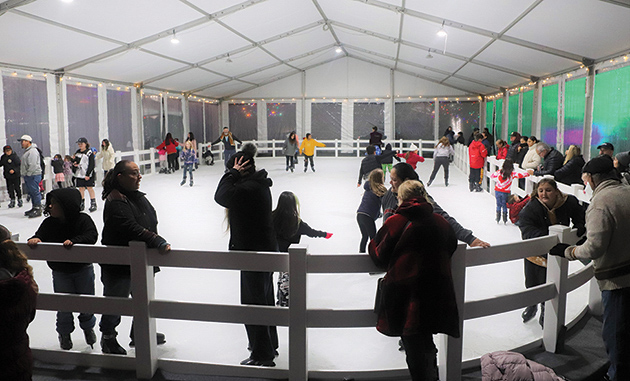
Present to witness the ceremonial switching on of the lights was Patrick Walker of Gig Harbor, owner and operator of P. Walker Inc. who was contracted to install QCV’s electric atmosphere.
“Tulalip’s entire Quil Ceda Village display entails 3.1 Million lights. There’s two million at the casino, eight-hundred thousand in the amphitheater and another two-hundred thousand at the bingo hall,” said Patrick. “Timeline-wise, we started on October 3rd and worked seven days a week up until November 22nd. I’d estimate it was about six-thousand man hours in total from an average crew of 15-18 hardworking guys. We had nothing but good experiences working with the Tribe, and I can attest to the fact that in the entire state of Washington there’s not another light display bigger.”
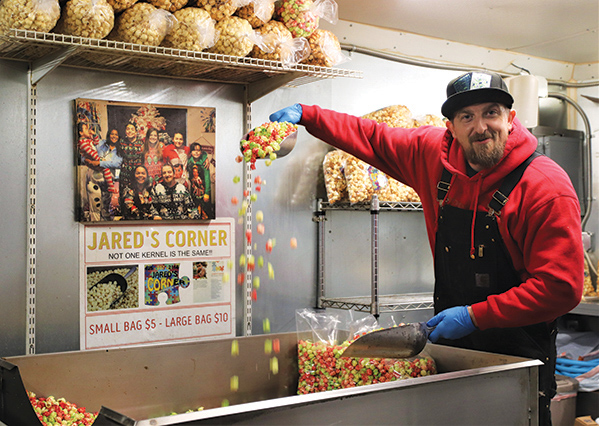
Open to the public now until January 8th, QCV’s ‘Lights & Ice’ is set to feature a variety of food vendors, craft vendors, weekend Dickens Carolers, and even cameos by Santa and Mrs. Clause. For more information and hours of specific festivities, please visit www.quilcedavillage.com
November 19, 2022 syəcəb
Please use the following link to download the November 19, 2022 issue of the syəcəb
Ballin’ with a Braid
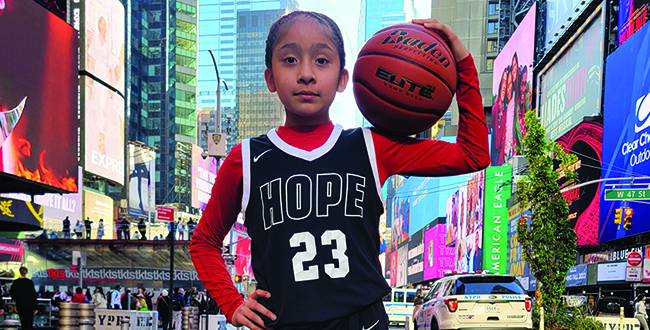
By Micheal Rios, Tulalip News
November is Native American Heritage Month. A time to celebrate rich and diverse cultures and traditions, and to acknowledge the important contributions of Native people. Heritage Month is also an opportune time to educate the general public about tribes, to raise a general awareness about the unique challenges Native people have faced both historically and presently, and the ways in which tribal citizens have worked to overcome these challenges.
Most people should know Native peoples aren’t a monolith. That is to say each of the 574 federally recognized tribes is unique, each with their own set of traditional teachings stemming from treaty rights, connection to regional lands and resources, and level of economic freedom to express tribal sovereignty.
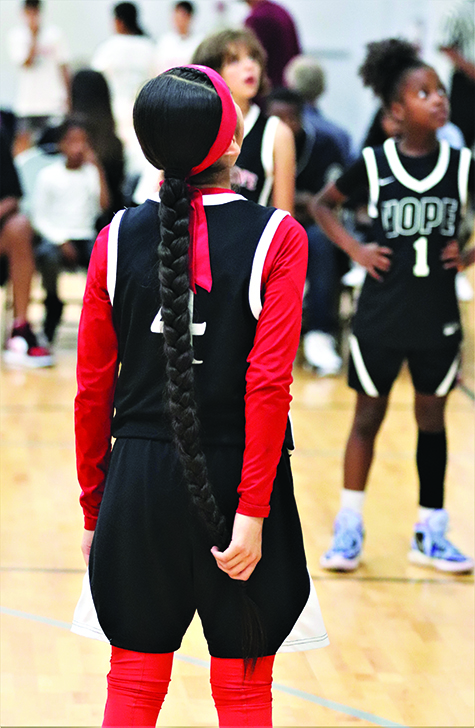
Encompassing each tribe is a beautiful diaspora of tribal citizens who live their lives expressing their own sense of personal identity according to a unique set of cultural values, whether that be traditional or contemporary or some combination of both. For young Tulalip phenom Charlie Contraro, the answer may be both or, better yet, simply something as unique as she is.
For starters, Charlie isn’t just a girl who plays basketball. She’s a hooper. Meaning she has the offensive range to shoot a deep 3-ball just as easily as she could beat her defender off the dribble and score a lay-up. And defensively she’s even better. Willing to dive on the deck for a loose ball, defend her opponent’s best or biggest player, and really, like for real, really looks forward to someone attempting a shot within her vicinity so she can swat that thing outta there like Dikembe Mutombo.
“I’d rather have a game saving block than a game winning shot,” said the defensive minded Charlie as she detailed her October basketball tournament in New York. “Because when my team is up or we’re already winning, then I can really get after it [defensively] and get lots of blocks. Yeah, I like blocks instead of shots for sure. I got lots of blocks in New York. So many that my mom started calling me Charlie Mutumbo.”
Measuring in at 4-foot-11-inches, Charlie is typically one of the tallest girls on the court when she’s playing within her own age group. That level of verticality, plus her swift movement, allows her to soar through the air in pursuit of her coveted blocked shots. However, the recently turned 10-year-old often plays multiple years up against competition older and more physically mature. It’s a welcomed challenge that gives Charlie plenty of opportunity to play her favorite position – point guard.
“Charlie’s been a baller since the womb,” said her mom Annie Jo Parish proudly. She’s well known as Miss A.J. from her years of teaching at Tulalip Montessori. “I played ball until I was at least six months pregnant with her. Then as a toddler she would watch from the sidelines as I coached her older sisters at the boys and girls club. She was at all their practices and at a certain point she started participating in their drills and conditioning exercises. So, really, Charlie has always been immersed in basketball culture, but she had to be patient and wait her time to play because, generally, competitive teams for girls don’t start until 4th grade.”
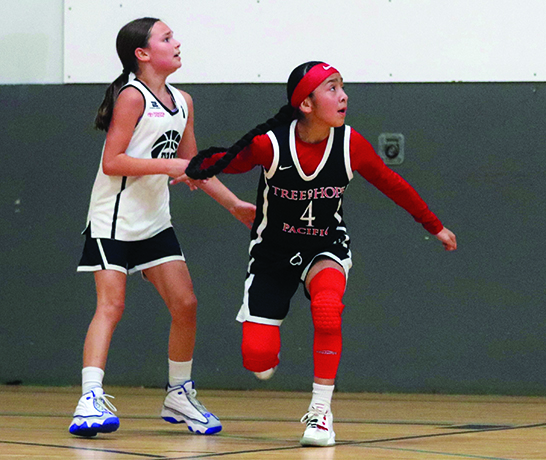
Now, after years of watching and learning from her sisters, the Jackson Elementary 4th grader has been unleashed to play to her heart’s desire on select level travelling teams. She’s also a regular on the Native tournament circuit, playing with older competition and against the boys.
No matter the competitive setting, whether it be on concrete or hardwood, Charlie is impossible to miss on the basketball court because of a Native asset she’s been growing her entire life, her hair.
Charlie’s near body length, beautiful black hair is a form of cultural expression naturally woven all the way back to her earliest ancestors. There are many teachings and practices that vary from tribe to tribe and generation to generation, but one that is near constant since time immemorial among all the tribes is the importance of hair to cultural identity. A Native American’s hair is considered sacred and significant to who they are as an individual, family, and community.
In many tribes, it is believed that a person’s long hair represents a strong cultural identity. For young people especially, a strong cultural identity promotes self-esteem, self-respect, a sense of belonging, and a healthy sense of pride. For Charlie, the constant chatter about her hair from teammates and competition is something she uses to elevate both her game and her culture. In fact, a few of the gyms she’s showcased her budding basketball talents at thus far, she’s been referenced as the baller with the braid.
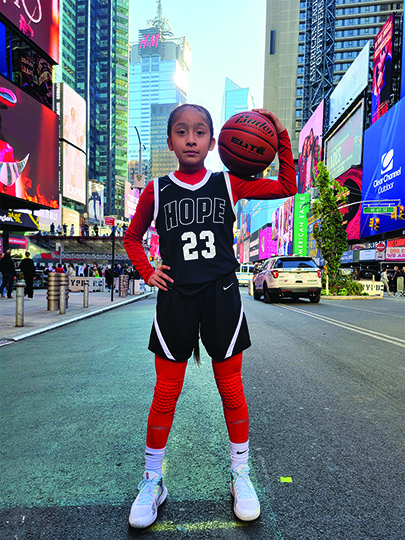
“Some of the things I hear all the time on the court is ‘Wow, your hair is really long!’, ‘Can I have some of your hair?’, ‘Your braid is so big. I wish I had hair like that’ or even ‘You’re like Rapunzel except your hair is black’,” reflected Charlie with a huge smile. “It’s cool to get compliments about my hair from my teammates and people I’m playing against, too. My mom tells me all the time that my braid is my signature.”
How we as Native Americans relate to our hair is a constant reminder of our connection to our culture and a distinct worldview grounded in the sacredness of relationships. Braiding a child’s hair is the beginning of establishing an intimate and nurturing relationship. For Charlie, it’s her father Mike Contraro who braids her hair before basketball games and practices.
“It makes me so proud to watch her playing the game she loves, running up and down the court with her braid trailing behind her,” said Mike during an intermission between Charlie’s tournament games. “It’s funny, too, because if you watch her, Charlie has a habit of rubbing the end of her braid in between free throws or during timeouts. Almost like it’s a lucky charm.”
Sure enough, during Charlie’s next game she was spotted at the free throw line holding the end of her braid before she swished one in. Maybe its muscle memory from a lifelong relationship with her hair and her parents braiding it before sports, or maybe it’s a continuation of her family’s grounding practices they do during travel.
“When we travel, my older daughters and I practice grounding or what’s sometimes called Earthing,” explained momma bear A.J. “This is something Charlie does, too. We’ll go barefoot in a safe space and take time to ground, reflect and reconnect with the Earth. The intention is to allow the Earth’s positive charges to enter through our feet and reconnect our bodies to our natural world.”
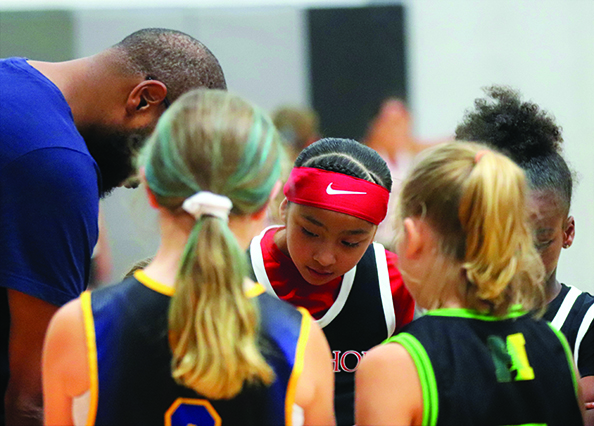
The inspiring 10-year-old hooper and her family have recently returned from a Nike Phenom camp in the sunshine state. Charlie’s mom shared that shortly after landing in California they went on a hike near the Golden Gate Bridge, where they were able to take in the iconic view while grounding themselves.
Her stellar play in California resulted scoring high in all her player evaluations and an exclusive invitation to Phenom National Camp in 2023. Her parents’ dedication to their youngest child, from the countless miles driven to her practices along the I-5 corridor and east side near Issaquah to the hours in the gym rebounding tirelessly as their daughter shoots jump shots, continues to bolster Charlie’s love for the game. She looks forward to filling out her skill set and working on her step back 3-pointers like she sees her favorite Seattle Storm players, Sue Bird and Breanna Stewart, routinely hit on the game’s biggest stage.
“Charlie is a scorer, a defender and an extra point guard. And she can play big. She can pretty much do everything on the court,” said 5th grade Nike coach Chris Nolen. Charlie plays a year up to play on Nike’s Tree of Hope team. “She’s been a huge addition for us. She’s a starter and gets a lot of minutes.
“Any time you have a player playing with older competition that means they have a huge competitive spirit. I can always count on Charlie to compete on both ends of the floor,” her coach continued. “Tree of Hope is an AAU type program and under the Nike banner. We are part of the national recognition level which is really competitive. We want to prepare our players for the next level, and we want to win. Charlie definitely helps us win.”
Winning comes in many forms. There’s the score of the game and the game of life. For Charlie, when asked what some of her favorite basketball memories are, she responded with the most whimsical tales from shooting in the wrong basket once to seeing huge flocks of pigeons while in New York.
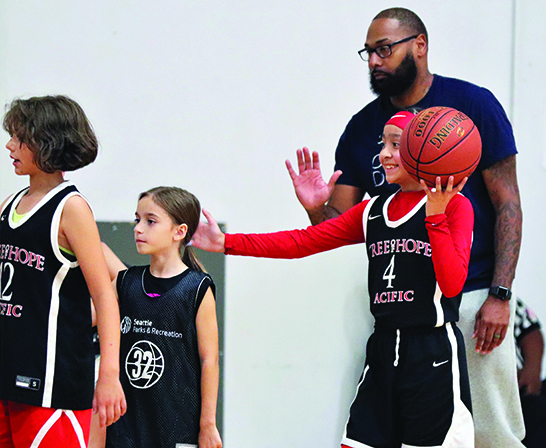
However, ask her about being challenged in basketball by boys at her school and her tone changes dramatically. “Oh, they always want to challenge. Most of the time I’m the only girl they’ll pick to play with them, even though others will watch from the side. One time this boy who is a bully tried guarding me and I dribbled between my legs, crossed over and then between the legs again into a jab step…he went for the fake and fell to the ground. Then I made the basket. Everyone watching started cheering and saying things like ‘OHHH!’ That was a pretty cool.
“Some boys say girls can’t play basketball, but they’re wrong,” she added defiantly. “Just look at woman’s college basketball or the WNBA. Those are professional girls getting paid big bucks to play basketball. Hopefully, that’ll be me one day.”
Charlie dreams of playing for one of the biggest college programs after graduating high school in 2031 before moving onto the WNBA. Which WNBA team? The Seattle Storm of course. Her mom is also planting seeds through all the travel basketball that she could continue her ball is life dream in far off lands like Europe or even China where they have huge followings for professional women’s basketball.
Until that dream comes true, Charlie and her signature braid will continue to work on perfecting fundamentals, beating the boys whenever possible, and being a beacon of inspiration to her Native American peers.
Make Tulalip your shopping destination this holiday
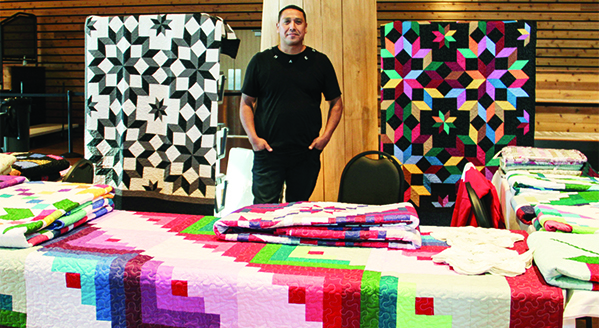
By Shaelyn Smead, Tulalip News
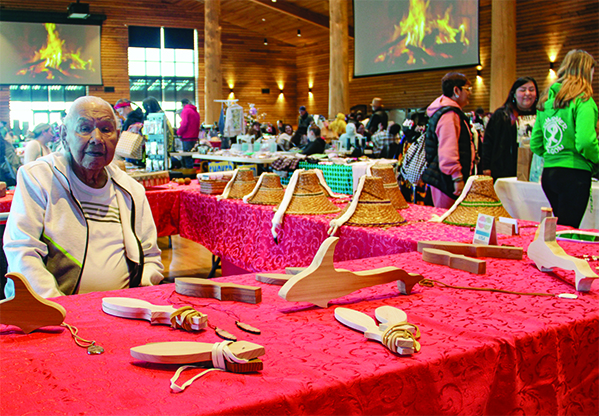
The holiday and gift-giving season officially kicked off with the annual Native Bazaar, held November 11-13. The Tulalip community showed up in droves as various tribal vendors sold their handmade crafts, baked goods, and art pieces.
This year’s event was tied for the largest Bazaar Tulalip has had thus far, with over 50 vendors committed. The event also needed a new place to settle into as the vendor list expanded and their collections grew. Ultimately, event coordinator Tammy Taylor, moved the bazaar from the gym to the Gathering Hall.
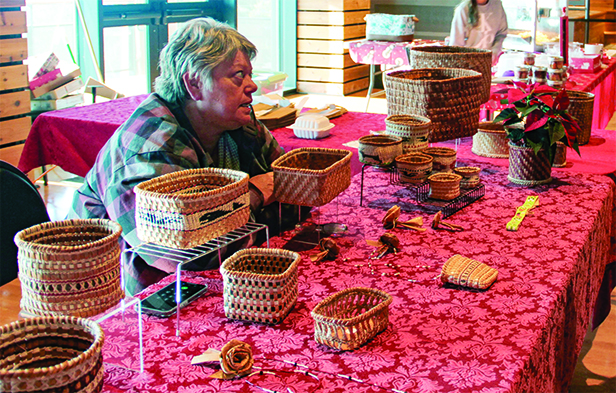
“This year was so successful. We had so many great vendors, and many of them sold out. Many of our membership, customers, and non-Natives were also in awe of how beautiful the Gathering Hall is. There really is no other building like this close to us, it is our sacred spiritual home, and it feels so good to have shared the bazaar there,” Tammy said.
A highlight of Native bazaars is that you find highly sought-after cultural pieces like drums, rattles, dreamcatchers, beaded jewelry, ribbon skirts, cedar hats, etc. Items like these are sacred to our culture and community that you can’t find in a typical retail environment. Even though the event is open to all, it creates a safe place for Native artists to sell their handmade crafts and keep them within our community.
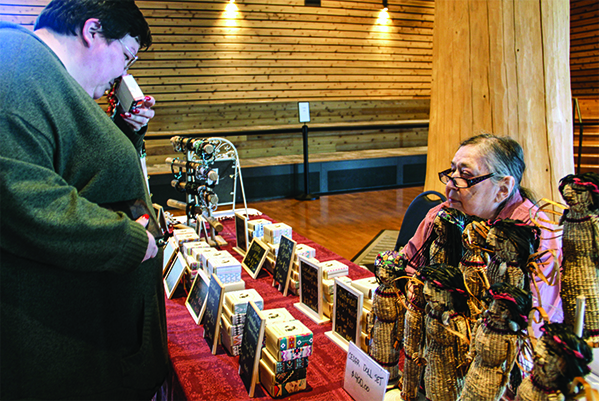
Specialty goods like salves, lemongrass soaps, and local berry baked goods represent our community’s desire to maintain our traditional ways while adapting to a modern world. Some vendors carried out this thinking style by turning dreamcatchers into crib mobiles, adding small cedar roses to store-bought home décor, transforming cedar dolls into Christmas tree toppers, or simply using acrylic and contemporary materials for their craft making.
Ultimately, curating these crafts, goods, and art stems from our traditional ways. As seen at many of the bazaar booths, these traditional art forms are usually multi-generational. They illustrate the ways of our people, passing down a skill and cultural practice from one generation to the next. Some of these pieces become less about the works themselves and more about the family teachings, cultural preservation, time spent together, and bonds built with our people. Elders and master artists hold a special place in our community because of their experience and expertise; learning from them, purchasing their work, and sharing this time with them helps build room for our culture in the future.
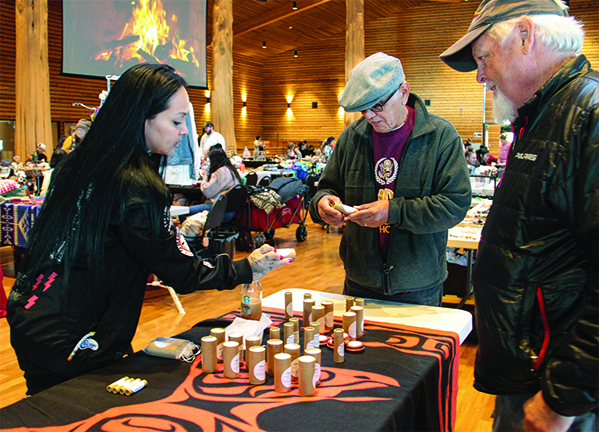
Tribal member and master weaver Lance Taylor has over 30 years of weaving experience. His work can be found all over the community at weaving workshops, but more importantly, within his home. Lance has shared this art form with his family to preserve weaving and as a part of his legacy.
“Weaving has been a part of my family for some time; my great-grandmother was a weaver and made baskets out of fern and cedar roots. I’m glad my family could pick it back up and pass it down to our grandchildren. That’s what it’s all about, passing it down to the next generation. There’s a sense of pride looking at our community wear our work,” Lance said.
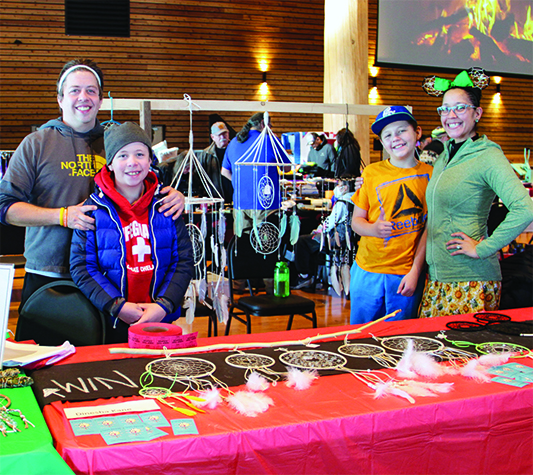
Tribal member Ronnie McClellan was seen selling handcrafted star quilts at the bazaar but gave full credit to his aunt and her friends. Like many other tribal artists, they consider their work a family business. Ronnie’s aunt and friends spend their days making quilts, and Ronnie will sell them for them at bazaars and community events.
“My family used to buy her quilts as gifts for people. But I wanted to help more. It’s such beautiful work, and there’s a lot of medicine in them. You can feel all the prayer, love, and passion that my aunt and her friends have for their work through the blankets. In our culture, it’s an honor to be blanketed and receive this medicine. It’s humbling, and I feel honored to represent her lifelong work. I love seeing people’s smiling faces when they buy a quilt, and I know they will cherish it.”
If you missed November’s Native Bazaar, don’t fret, you can support these Native artists and more at the next Native Bazaar, December 9-11, at the Gathering Hall. The event will also expand for more tribal vendors to join, so if you have any questions, please call Tammy Taylor at 425-501-4141.
Native Veterans honored with National Monument
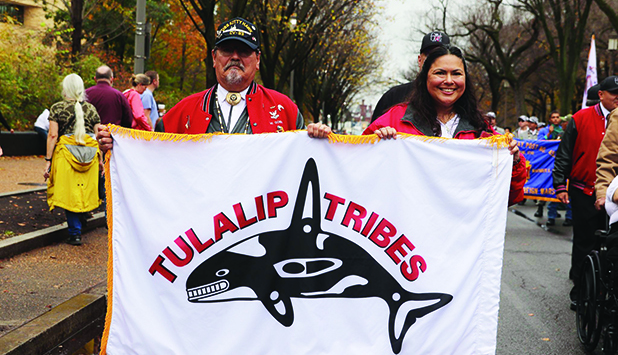
By Kalvin Valdillez, Tulalip News
“Even though it rained on our parade, it was awesome,” exclaimed Tulalip Veteran, Dan Bradley (Marine Corps ’72-’74). “As we were walking through the parade all the spectators were clapping, giving us the thumbs up, and saying thank you for your service. It felt good.”
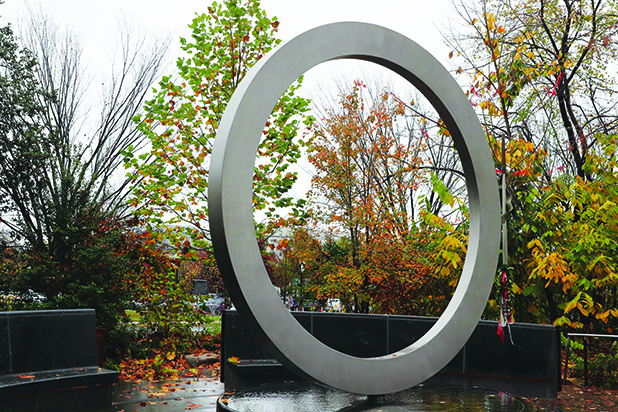
For the first time in the United States’ history, Native American service men and women have a monument to call their own, which honors and pays tribute to thousands of veterans from tribes all across the nation. Located on the National Mall in Washington D.C., the circular monument stands in front of the Smithsonian National Museum of the American Indian and was designed by Harvey Pratt (Cheyenne and Arapaho Tribes of Oklahoma).
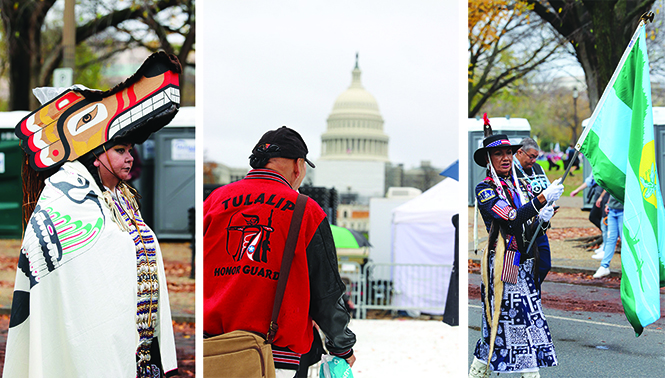
According to the Smithsonian website the memorial is, “an elevated stainless-steel circle balanced on an intricately carved stone drum, the design of the National Native American Veterans Memorial is simple and powerful, timeless and inclusive. The design incorporates water for ceremonies, benches for gathering and reflection, and four lances where veterans, family members, tribal leaders, and others can tie cloths for prayers and healing. The memorial creates an interactive yet intimate space for gathering, remembrance, reflection, and healing. It welcomes and honors Native American veterans and their families and educates the public about their extraordinary contributions.”
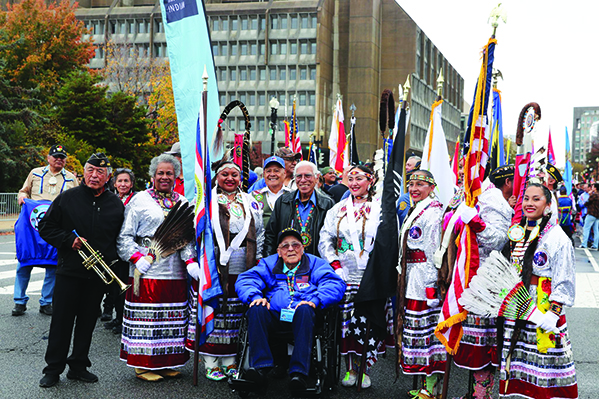
Construction on the memorial began prior to the pandemic and due to social gathering limitations, the Smithsonian was unable hold a celebration when the memorial was complete. Once limitations lifted, plans for a dedication were quickly set in place and invitations were sent to tribal veterans across the country.
The dedication of the National Native American Veterans Memorial took place this year on Veterans Day. Hundreds of brave and proud Indigenous veterans traveled to Washington D.C. to take part in a historic moment, not only for Native America, but for the entire country as well.
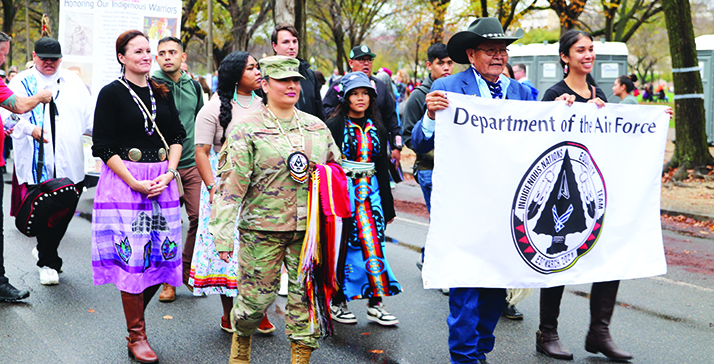
The memorial was commemorated with a procession through the streets of D.C. and many veterans wore their traditional regalia and sang and danced to their ceremonial songs. Sage filled the air while the vets proudly carried their tribes’ respective flags, the U.S. flag, the POW flag, and a few eagle staffs were sighted too.
After nearly a mile march, through wet streets and humid and rainy conditions, the veterans arrived at a stage that held this nation’s capital building in the background. A timelapse video of the erection of the monument played from start to finish, and various tribal leaders spoke about what the memorial means to those tribal members who bravely defended America’s freedom.
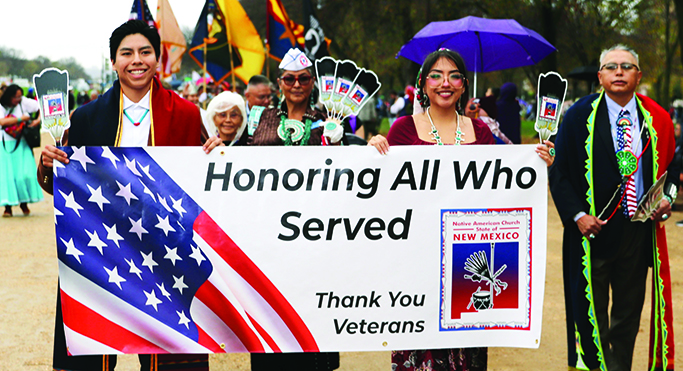
Veterans from the Vietnam War, the Korean War, Desert Storm, and the Global War on Terrorism were in attendance, including 28 Tulalip veterans. The highlight for many of these brave warriors was meeting Navajo Code Talker Thomas H. Begay, who marched alongside his fellow Native veterans during the procession. And among all the family members and supporters cheering on the veterans during the procession were Kansas Rep. Sharice Davids (Ho Chunk) and Actor and Film Producer Wes Studi (Cherokee), who many people were excited to meet and take selfies with.
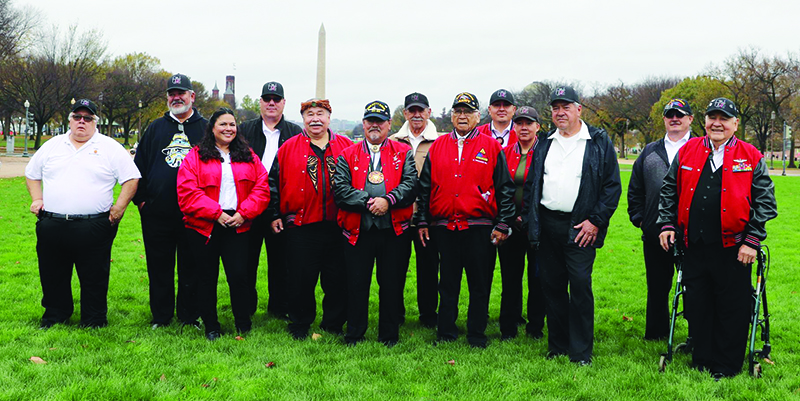
The Tulalip veterans, along with many other veterans from around the nation, enjoyed an extended stay in D.C. following the Veterans Day ceremony. The vets had the weekend to explore the busy and scenic District of Columbia; some spent their time visiting sites like the Vietnam Veterans Memorial Wall and the Arlington Cemetery to pay their respects to their fallen brothers and sisters in arms, while others visited the Capital, the Lincoln Memorial, the White House, and several of the historic museums, such as the four-story National Museum of the American Indian.
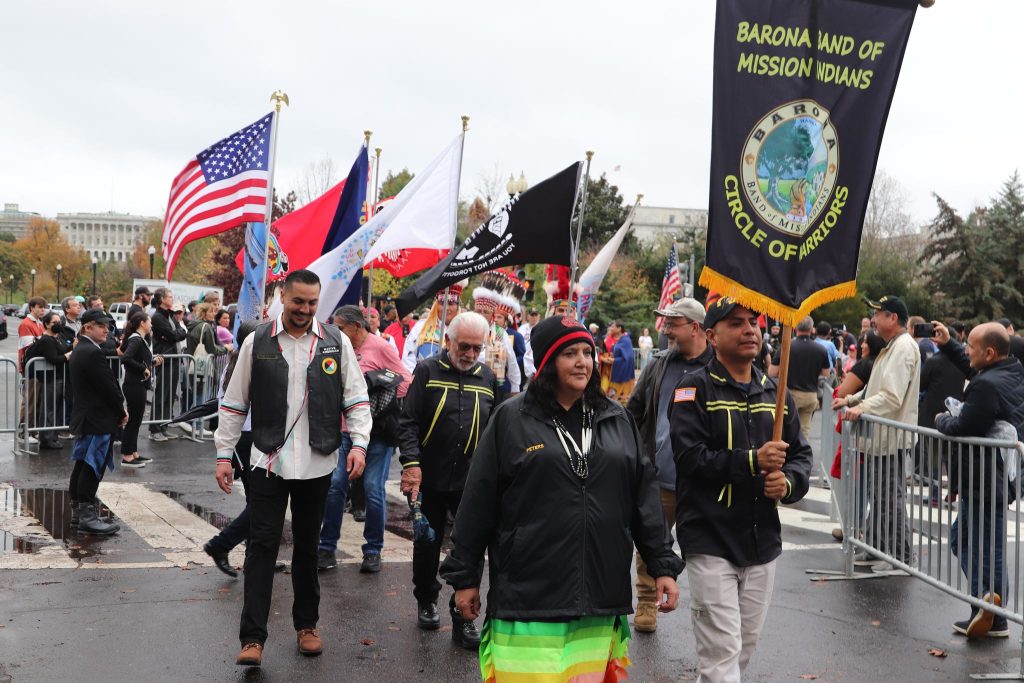
“The most important thing I hope our veterans take away from this are the memories,” said Tulalip Veterans Coordinator, William McLean III (U.S. Marine Corps 03-07). “It’s not often the entire nation comes together to honor tribal veterans; this is probably a once in a lifetime opportunity. I’m hoping they take good memories and that they enjoyed themselves.”
___________________________________________________________________________
Tulalip Vets visit Washington D.C.
Twenty-eight veterans traveled on a direct flight from Sea-Tac to the Ronald Reagan Washington National Airport to witness and participate in the dedication of the National Native American Veterans Memorial at the National Museum of the American Indian. After a moving ceremony which took place on Veterans Day, a handful of Tulalip Veterans took the time to reflect upon their visit to D.C. for the historic dedication.
Cara McCoy Tohannie, US Army
We flew from Tulalip and got here a couple days early so we could explore. My dad was actually stationed here, so we lived here for a while. We went to the Arlington Cemetery for a walking tour, we had the procession, and we went on a night tour of all the monuments. It was great to see all the Native American veterans from around the United States in the procession. I felt really proud to be here because it’s a once in a lifetime opportunity, to be able to represent Tulalip. My dad, my grandpa, and my uncle were also in the military but couldn’t be here.
It’s great that they have a monument specifically for Native American veterans. I think having it on Veterans Day is significant because it’s important to honor veterans, and of course November is Native American Heritage Month, so just to have everything come together, it felt pretty amazing.
Dan Bradley, US Marine Corps.
We came from Orange County near Disneyland. I really enjoyed it and it’s about time, because look at all these years that have gone by, and they finally have done something for the Native American Veterans to recognize them. We haven’t been recognized like this before, so I thought it was awesome that this happened. A lot of people came from different tribes. It took a while because of the pandemic, but here we are.
Cyrus Hatch III, US Marine Corps.
I’ve been looking forward to this for months! I want to thank the Tulalip Tribes, the Board, the Vet department. I was stationed here for years, twice, and it’s great to be back. It’s a walk down memory lane to see everything again. I haven’t been here since ’89. Good thing it was rainy because I was getting misty eyed. I’m really happy we have a memorial and something to reflect on us to be proud.
Hank Williams Sr., National Guard & US Army
It was wonderful. It’s probably something that happens once in a lifetime. We get to see and meet friends, people from different states and tribes – all friendly people, and get to know each other – where were from, what we did, what service we were in.It was exciting to shake hands with everybody.
That parade we had, we got see a whole bunch of people, I haven’t seen so many Indians in my life. I carried the flag which was an honor for me. I’m 92 years old and I can still get around and I was proud to do it and help show off my tribe and people. Not all the veterans came, some couldn’t make it. A lot of our veterans are old age now, we are from Korea and Vietnam.
David Fryberg Jr., US Marine
It was a great experience. I never had such feelings and receive such blessings from seeing some of these Cherokee and Comanche warriors from other tribes that really went out and did what they did. We are asked to do a lot of things that other people wouldn’t do.
I had a great time here in D.C., I was even able to sneak off and do an Okinawa reunion with my best friends in Philadelphia. The comradery you build in the service, its beyond brother and sister, it’s something I can’t even describe. Thanks Tulalip tribes for sending us here, for the procession and to commemorate the Native American war memorial. It’s here. It exists. It’s been a long time coming. It’s an honor to join the service and do what I did, and know that someone is grateful and appreciative of it.
Richard Dean Ledford, US Air force
I’m so thankful to be a member of the Tulalip Tribes and I’m proud of that. This is my second visit here. There are so many things to see. The National Museum of the American Indian, you get to go on each floor and read about all the different stories of what took place over the years. We’re all proud members who were trained to be warriors. This is important because I know we lost a lot of tribal veterans over the years, I’m happy we got to be here together and that we get to pass this on to the members of Tulalip.
To see the people supporting you, clapping, it was great. I was wondering if I was going to make it with my walker, but I did all the way around. It was great to see all the different tribes and veterans.
Raymond Fryberg, US Marine Corps
It was a really unique opportunity because I know for a fact, per capita wise, Native Americans volunteer more than any other ethnic group in the United States, and I was proud to be part of that. At Tulalip, one of the veterans in WWI Elson James, they wrote back to his mother that it was possible he was the first Native American causality.
In WWII and the Korean War, we had some really highly decorated veterans. One of my uncles had his leg shot off, he was a medic. And one of my dad’s first cousins was a paratrooper who was shot and wounded in an air drop. And of course, the late Teat-mus (Raymond Moses) was very decorated in the Korean war, he had a silver star, bronze medal, and a lot of purple hearts. Because he was Indian, he knew a lot about terrains and being out in the environment, he was very effective, they looked to him a lot to help them out.
I took a picture with one of the code talkers. They influenced the war; that gave us an advantage in WWII. And a lot of the others who were here, a lot of people from Vietnam and the Korean War. I’m proud to be a part of that because I appreciate my freedoms in this country – freedom of speech and the right to vote. They laid it all on the line for it.
Morena Lopez, US Air Force
I’m coming from San Antonio, Texas. It’s really awesome because I didn’t grow up on the reservation, so I don’t really know anybody here. Being able to meet everybody and connect and find out how we’re related has been awesome. To be here on Veterans’ Day at the Nation’s Capital was phenomenal. I didn’t know about the museum, so that was really cool too and I saw that our tribe was recognized in there and I felt like a fan girl.
When Bill asked if anyone wanted to hold (the flag) I stepped up immediately. That was such an honor. I wanted to hold our flag because I’m not that involved with the reservation, the tribe and our ways, that felt like a way to connect. In some ways it felt like a big powwow, I really enjoyed that comradery and listening to the singers, the drumbeats and the burning of the sage. And to have people on the side cheering us on, I thought was really neat as well.
This has been the greatest thing that happened to me since I retired. Thank you for the Tulalip Veterans group to invite me and keep me involved, I’m so grateful and blessed.
Rocky Renecker, US Army
It was surreal. I got to view veterans from all over, and they’re all Indigenous so it meant a lot to my spirit and heart to see. We’re still here. To see them all in their regalia and their uniforms and all the different colors, it was really surreal to be able to march with not only my fellow Tulalip veterans but my fellow Indigenous veterans from all over the country and be a part of this. It’s going to mean a lot to me for the rest of my life.
It’s nice to be here to represent Tulalip, our community, and the rest of the veterans at home. It’s an honor to be able to stand for them and march and be present for the ceremony. The memorial, I like the simplicity of it, it’s right to the point. Everything about us is full circle, so it hits home.
William McLean III, US Marine Corps.
The tribe donated a few years ago when the project was first getting started. When we found out about it, I thought it would be good to send as many Tulalip veterans as possible to represent the tribe. The memorial has been up for a few years, but they had to shut down the in-person dedication ceremony. And when they decided to host one, I got everything situated and got as much funding as possible.
Getting 20-40 people situated on a cross country trip is a task, but once we got passed all the speed bumps and ironed out all the wrinkles and got everybody here, I think it went well. I really hope everyone enjoyed themselves. My only goal was to represent for Tulalip and in doing so have Tulalip veterans enjoy themselves.
The gathering was unique, it was powerful. There are not very many opportunities for so many tribal people to come together from all over the nation. It’s really good to see that people care and are willing to take time, effort, funding. And just in general, that feeling of having people’s admiration and respect for doing something a lot of people wouldn’t do is good to see.
November 12, 2022 syəcəb
Please use the following link to download the November 12, 2022 issue of the syəcəb
Native American Heritage Reads
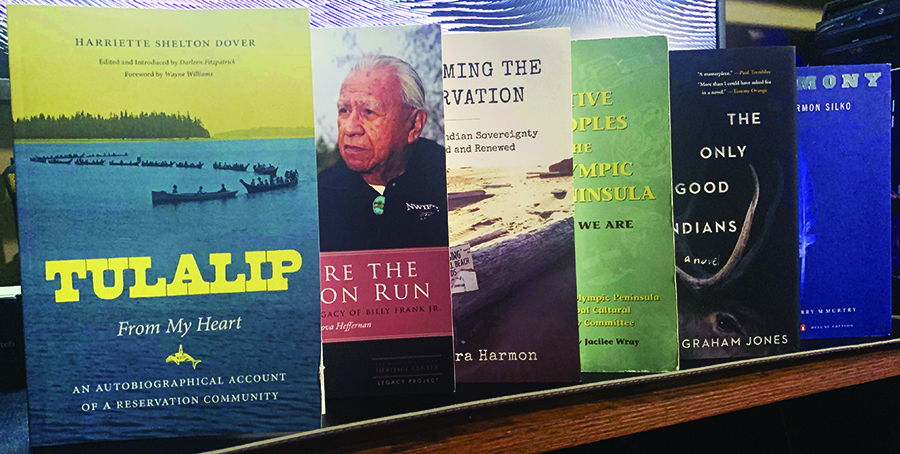
By Kalvin Valdillez, Tulalip News
We’ve reached another November. As the temperature drops and the leaves continue to fall, now is the perfect time to grab your favorite hot beverage, whether that’s hot cocoa, peppermint or pumpkin spice lattes, herbal tea, or hot cider, and curl up with a good book.
Now a national celebration, Native American Heritage Month happens to land every November. While most of the country is focused on shopping for the upcoming Christmas season, many are taking the time and space to honor, celebrate, and learn about the true history of the many tribes, bands and families who are Indigenous to North America.
Below, we’ve compiled a book list for you to check out during Native American Heritage month. Although there are numerous Native storytellers who have had their works published over the years, we wanted to highlight a few books that have local ties, as well as a couple authors who are well-known in the community of Native writers. And if you are out and about shopping for the perfect gifts, a few of these recommendations are available through audiobook platforms such as Audible, and often times feature a Native narrator. And while you’re at it, pick up one of these great reads for the reader in your family.
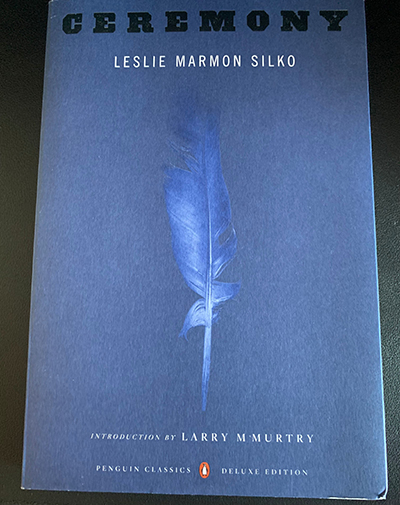
Ceremony by Leslie Marmon Silko
We are starting off with a classic. Ceremony was first published in 1977 and has served as inspiration for Native Novelists ever since. Sherman Alexie stated that Ceremony is the greatest novel in Native American literature, making Leslie Marmon Silko your favorite Native author’s favorite Native author. We also chose this novel because of the main character’s experience in the U.S. military, and as you may know, Tulalip is home to countless proud and brave veterans who also defended this country’s freedom and returned home to the reservation with PTSD.
Set in the Insular world of the Laguna Pablo Reservation but resonating far beyond, Leslie Marmon Silko’s novel tells the story of Tayo, and army veteran of mixed ancestry who returns to the reservation, scarred by his experience as a prisoner of the Japanese. Only by immersing himself in the Indian past and its traditions can he begin to regain the peace that was taken from him. Masterfully written, filled with the somber majesty of Pueblo myth, Ceremony is a work of enduring power.
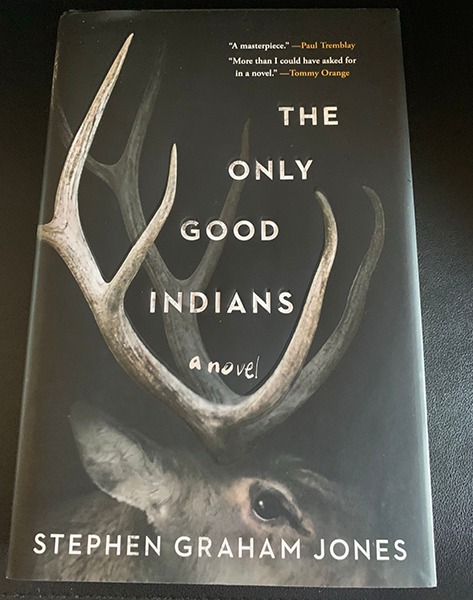
The Only Good Indians by Stephen Graham Jones
Stephen Graham Jones, a.k.a. the Indigenous Stephen King, has been on the Native writing scene since the early 2000’s. With over 20 books published, he has shared a number of twisted, haunted, and thrilling stories while weaving traditional tales, cultural concepts, Indigenous issues, and reservation life into each chapter. Once you read a Stephen Graham Jones novel, you are automatically going to want to check out his other works. And might we suggest the shapeshifting novel Mongrels, the fancy dance horror fiction Mapping the Interior, or two modern slashers with Native leads The Night of the Mannequins and My Heart is a Chainsaw.
Seamlessly blending classic horror and a dramatic narrative with sharp social commentary, The Only Good Indians follows four American Indian men after a disturbing event from their youth puts them in a desperate struggle for their lives. Tracked by an entity bent on retribution, these childhood friends are helpless as the culture and traditions they left behind catch up to them in a violent, vengeful way.
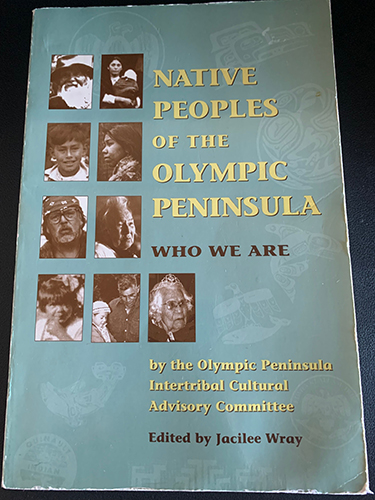
Native Peoples of the Olympic Peninsula: Who We Are by the Olympic Peninsula Intertribal Cultural Advisory Committee
With a page count of 162, this short read can be enjoyed during a quiet afternoon or over the course of a weekend. However, Native Peoples of the Olympic Peninsula: Who We Are will most likely be found in the hands of college students as this particular book serves as the focus of study for many Intro to Native Studies courses, especially in the Pacific Northwest. Locally, this text is often utilized in classrooms at the University of Washington, Shoreline Community College, Everett Community College, Northwest Indian College, and the Evergreen State College. This read gives insight to the Tribes whose homelands are located on the coastline of the Olympic Peninsula and focuses on their traditions, stories, and way of life. Plus, the book is filled with remarkable illustrations, maps, and photography. (And on page 112, you’ll find a shot of yours truly, as cute as can be at the age of four, before my claim to fame with Tulalip News.)
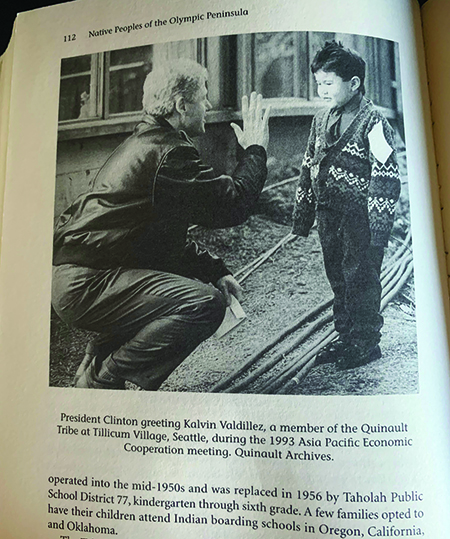
The Native tribes of Washington State’s Olympic Peninsula share complex histories of trade, religion, warfare, and kinship. Yet few books have depicted the Indigenous People of this region from a Native perspective. Native Peoples of the Olympic Peninsula: Who We Are introduces readers to nine tribes: the Elwha Klallam, Jamestown S’Klallam, Port Gamble S’Klallam, Skokomish, Squaxin Island, Quinault, Hoh, Quileute, and Makah. Written by members of the Olympic Peninsula Intertribal Cultural Advisory Committee, edited by anthropologist Jacilee Wray, and enhanced by photographs and maps, the book is divided into sections focusing on each of the tribes. Each section relates the tribe’s history, its current cultural and political issues, and its tribal heritage programs. Each section also includes information about places to visit and offers suggestions for further reading.
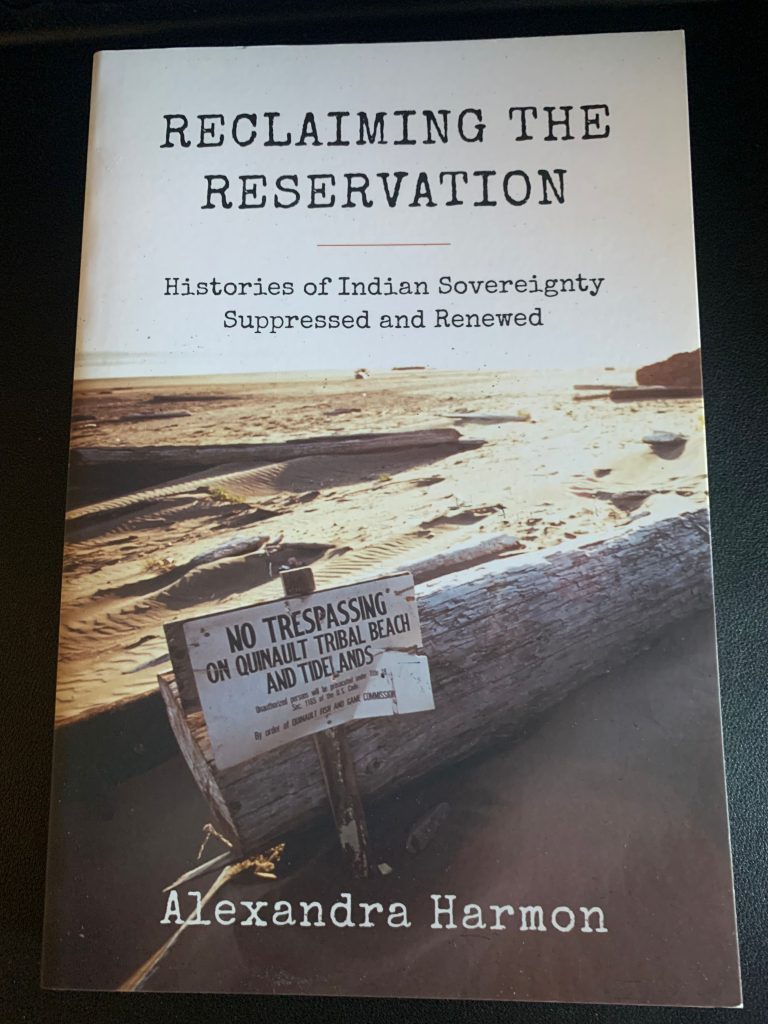
Reclaiming the Reservation: Histories of Indian Sovereignty Suppressed and Renewed by Alexandra Harmon
Reclaiming the Reservation is a deep dive into tribal sovereignty, specifically centered around the Quinault and Suquamish tribes in the 70’s, and their jurisdiction, or lack thereof, over non-Natives on their reservations. The book opens up with Quinault’s decision to bar non-tribal members from their scenic beach in 1969 due to pollution, stolen gill nets, and the defacing of seaside rock formations that are important to the tribe’s heritage. To this day, non-tribal members are still prohibited from stepping foot on the Point Grenville beach that is more commonly known as ‘the Indian beach’, ‘the big beach’, or simply ‘our beach’ by Quinault members. Another large portion of the book focuses on Oliphant v. Suquamish where the Supreme Court ruled that tribal courts have no criminal jurisdiction over non-Indians in 1978. The book was written by Alexandra Harmon, emerita of American Indian Studies at the University of Washington and supported by a grant from the Tulalip Tribes Charitable Fund.
In the 1970’s the Quinault and Suquamish, like dozens of Indigenous nations across the United States, asserted their sovereignty by applying their laws to everyone on their reservation. The Supreme Court’s 1978 decision in Oliphant vs. Suquamish struck a blow to tribal efforts by ruling that non-Indians were not subject to tribal prosecution for criminal offenses. The court cited two centuries of US legal history as justification but relied solely on the interpretations of non-Indians. In Reclaiming the Reservation, Alexandra Harmon delves into Quinault, Suquamish, and pan-tribal histories and activism to illuminate the roots of Indians’ claim of regulatory power. She considers the promises and perils of relying on the US legal system to address colonial dispossession and shows how tribes have sought new ways to assert their sovereignty since 1978.
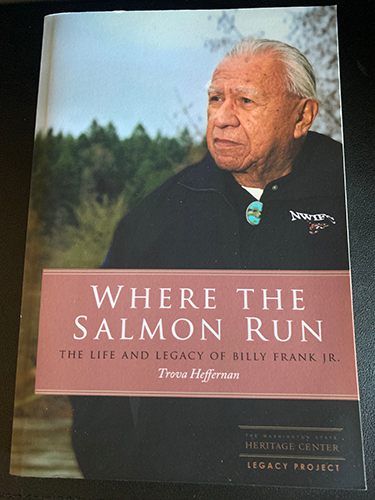
Where the Salmon Run: The Life and Legacy of Billy Frank Jr. by Trova Heffernan
Billy Frank Jr. Fish Wars. The Boldt Decision. Do we need to say more? This detailed account of the Native activist and Nisqually leader, Billy Frank Jr. is a must-read. The book is filled with quotes, interviews, photos and wisdom from the man who put his life on the line for Native fishing rights. He took part in fish-ins to demonstrate his right to fish in usual and accustomed areas, verbiage that is clearly stated in most Northwest tribal treaties. During these fish-ins people were arrested and beaten, and Billy was at the forefront of this movement that ultimately led to the Boldt decision. And of course, the book brilliantly depicts the leadership Billy displayed during the Fish Wars, as well as for his tribe following the Boldt decision, and for Indian Country as a whole.
Billy Frank Jr. was an early participant in the fight for tribal fishing rights during the 1960s. Roughed up, belittled, and arrested many times at Frank’s Landing on the Nisqually River, he emerged as one of the most influential Northwest Indians in modern history. His efforts helped lead to the U.S. v. Washington in 1974. In which U.S. District Judge George H. Boldt affirmed Northwest tribal fishing rights and allocated half the harvestable catch to the tribe.
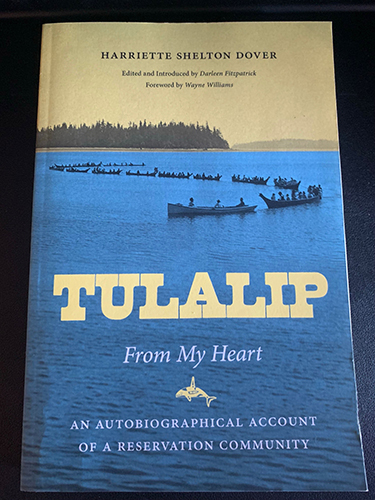
Tulalip, From My Heart: An Autobiographical Account of a Reservation Community by Harriette Shelton Dover
No bias here. We honestly think that this is the perfect read for Native American Heritage Month because it is informative about what many tribal nations went through following the signing of their treaties, but from a Tulalip perspective. This story includes a Lushootseed phonological key and introduces the traditional sduhubš language to any reader who picks the book up. Tulalip, From My Heart opens with the signing of the 1855 Treaty of Point Elliott and follows one of the most influential leaders, and the first Tulalip Chairwoman, through her life and trials while growing up Tulalip. For those who recently gained knowledge about forced assimilation, the boarding school era, and the Every Child Matters movement, this book recounts Harriette Shelton Dover’s time spent at the Tulalip Boarding School and covers all the atrocities she and her fellow tribal members experienced in the name of Catholicism. The book also sheds light on the Tulalip way of life and the traditions of her people, while also highlighting the tribe’s growth over the years. Along with the captivating, heartbreaking, and inspiring story, Tulalip, From My Heart includes photos from the Tulalip Boarding School as well as its daily schedule that the kids had to endure, and also photos of tribal members exercising their treaty rights and proudly engaging in cultural activities.
In Tulalip, From My Heart, Dover describes her life on the Tulalip reservation and recounts the myriad problems tribes faced after resettlement. Born in 1904, Dover grew up hearing the elders of her tribe tell of the hardships involved in moving from their villages to the reservation on Tulalip Bay: inadequate supplies of food and water, harsh economic conditions, and religious persecution outlawing potlatch houses and other ceremonial practices. The first Indian woman to serve on the Tulalip Board of Directors, Dover describes her experiences in her own personal, often fierce style, revealing her tribe’s powerful ties and enduring loyalty to land now occupied by others. She died in 1991 at the age of eighty-six.
Thanks for reading our suggestions, and if you do happen to check out any of these great books, please feel free to share your review with us. We hope everyone is having a great and informative Native American Heritage Month!
